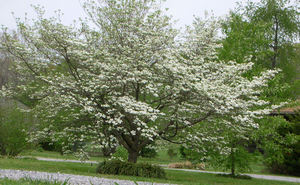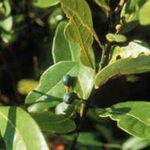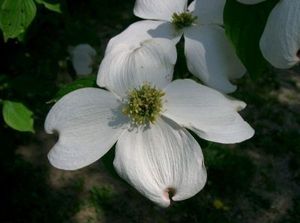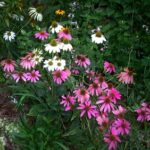The beautiful flowering dogwood tree will probably always be one of the most well loved trees in America. There are several varieties of the dogwood tree and even more plants in the same Cornaceae family. The classic and popular dogwood tree that is native to eastern parts of North America is the Cornus florida. Spring would not be as lovely if dogwoods ceased to exist in their native American habitat. The flowering dogwood lends a delicate and airy beauty wherever they are planted, whether by nature or the suburban gardener.
The flowering dogwood tree is known for its spring display of blooms which cover the branches for at least two weeks, depending upon the weather. Although it appears the flowers are the attention-getters, it’s actually the showy bract. They are a bright white when at their peak and appear before the leaves emerge. The dogwood is a tree that has interest in all four seasons. The flowers and leaf form, fall color, berries, winter bark and branch form. It has a roughly textured bark that is said to resemble an alligator’s skin and a shape that can stand alone in a winter landscape.
The bloom time will vary depending upon the location. In the south they begin to bloom in March or April, whereas the northern states won’t see blooms until May or June. The true flowers are the tiny greenish-yellow centers of the bract. The bract serves as protection for the flowers where the berries and seeds will be produced. Spring is not the only season for the dogwood to shine. It’s attractive green leaves turn shades of red and purple and last through the entire fall season.
Autumn is also the time to begin to see the dogwood’s shiny, red fruits. The flowering dogwood is a good choice to entice wildlife and birds to the yard. After the fruits start ripening, they won’t last long on the tree. Birds will devour them as fast as they possibly can. The leaves, twigs and berries are all high in calcium, protein and several other minerals. Large and small mammals use the dogwood for shelter and food including the gray and fox squirrel. The white-tailed deer also uses the twigs and leaves as a food source. More than 30 species of birds also rely on the dogwood as a food source but seldom as a nesting site.
In the winter, dogwoods also have beautiful bark and the next season’s buds adorning the limbs. Besides having multi seasonal interest, the Cornus florida is the perfect size to use as an ornamental tree for the average residential landscape. It usually only grows 20 to 25 feet high and about the same width. Flowering dogwoods can grow closer to 40 feet in height in the most extreme southern zones. The flowering dogwood is hardy from USDA Zones 5 to 9, although flower buds can be injured by cold in the most northern zones.
This American beauty is happiest when planted where it would live in the wild at the edge of woodlands. They grow naturally in the partial shade of larger trees and absolutely glow in their natural understory habitat. The flowering dogwood lives in the partial shade of beech, hickory, maple, oak and several other trees in the wild. Any tree or plant is going to perform better if the growing conditions can mimic its native environment as much as possible. The flower bracts appear larger and a more brilliant white when grown in partial shade.
The same variety of dogwood grown in full sun will appear more compact but will often have more blooms. It can do well in full sun if given enough water and the acidic soil they prefer in their natural environment. The dogwood prefers a cool, moist and acid soil. The soil in their native habitat will be rich with organic matter from the decaying leaves of the taller trees. Adding leaf mold or compost will help improve the soil around the dogwood. They will need to be well-watered in periods of drought.
It’s best to start with a small dogwood tree when adding one to the landscape. The smaller tree will suffer less transplant shock, and dogwoods take time to get established after planting. The tree can become stressed in extreme heat and drought conditions. The dogwood also doesn’t do well in an area with a lot of pollution and road salt. There is a fungal disease called anthracnose that dogwoods are known for getting in various parts of the country. The best defense against any disease is to keep the tree healthy and to mimic its natural environment as close as possible.
The Cornus florida has several cultivars available and they are all equally beautiful. These cultivars also allow the addition of pink and red dogwoods into the landscape. Pink dogwoods are a soft medium pink. The red dogwoods are not a true red but rather a deep hot pink. There are also cultivars available that begin with white bracts that age to a delicate pastel pink. There are several Cornus florida cultivars with variegated leaves in creams, pinks and greens. Each flowering dogwood is lovely and beneficial to the landscape.






